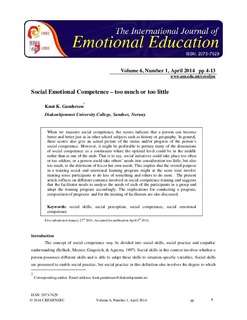Social Emotional Competence – too much or too little
| dc.contributor.author | Gundersen, Knut K. | |
| dc.date.accessioned | 2014-05-14T11:41:00Z | |
| dc.date.available | 2014-05-14T11:41:00Z | |
| dc.date.issued | 2014 | |
| dc.identifier.issn | 2073-7629 | |
| dc.identifier.uri | http://hdl.handle.net/11250/195019 | |
| dc.description.abstract | When we measure social competence, the scores indicate that a person can become better and better just as in other school subjects such as history or geography. In general, these scores also give an actual picture of the status and/or progress of the person’s social competence. However, it might be preferable to portray many of the dimensions of social competence as a continuum where the optimal level could be in the middle rather than at one of the ends. That is to say, social initiatives could take place too often or too seldom, or a person could take others’ needs into consideration too little, but also too much, to the detriment of his or her own needs. This implies that the overall purpose in a training social and emotional learning program might at the same time involve training some participants to do less of something and others to do more. The present article reflects on different continua involved in social competence training and suggests that the facilitator needs to analyse the needs of each of the participants in a group and adapt the training program accordingly. The implications for conducting a program, composition of programs and for the training of facilitators are also discussed. | nb_NO |
| dc.language.iso | eng | nb_NO |
| dc.publisher | CRES/ENSEC | nb_NO |
| dc.subject | social skills | nb_NO |
| dc.subject | social perception | nb_NO |
| dc.subject | social competence | nb_NO |
| dc.subject | social emotional | nb_NO |
| dc.title | Social Emotional Competence – too much or too little | nb_NO |
| dc.type | Journal article | nb_NO |
| dc.type | Peer reviewed | nb_NO |
| dc.source.pagenumber | s. 4-13 | nb_NO |
| dc.source.volume | 6 | nb_NO |
| dc.source.journal | The International Journal of Emotional Education (IJEE) | nb_NO |
| dc.source.issue | 1 | nb_NO |
Tilhørende fil(er)
Denne innførselen finnes i følgende samling(er)
-
Artikler / Articles [1172]
